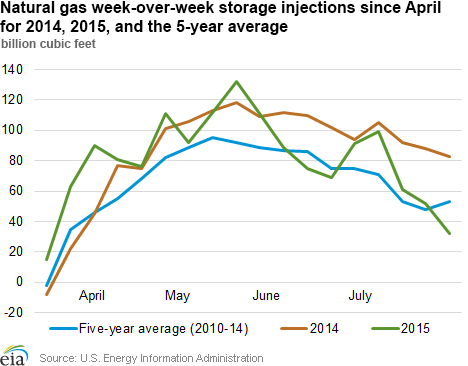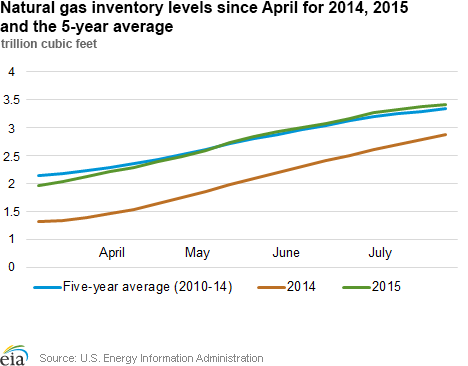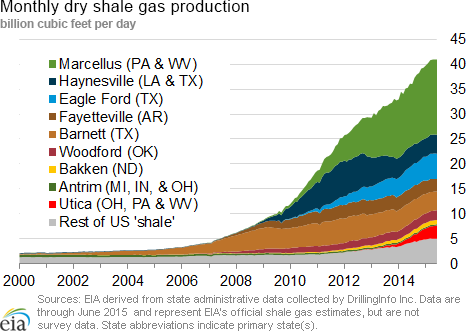In the News:
Injections of natural gas into storage since April are 20% higher than the five-year average (2010-14), but trail last year's record-high levels
During the first four months of the 2015 natural gas storage injection season, which typically runs from April through the start of November, injections have totaled 1,436 billion cubic feet (Bcf). Injections this year are 20% higher than the five-year average, but are 7.5% lower than last year's record-high levels over the same period. Inventories as of July 31 were 2,912 Bcf, 535 Bcf, or 22.5% more than 2014, and 64 Bcf (2.2%) more than the five-year (2010-14) average for the week ending July 31.
Injections this year have exceeded the five-year average level by 317 Bcf, but are 116 Bcf lower than injections in 2014 over the April through July period. In 2014, there were record high injections after storage fell to 10-year lows following an extremely cold winter. Similar factors associated with the remarkable storage rebuild in 2014 are also supporting the high levels of injections that are occurring this year, especially year-over-year production growth. In 2014, Lower 48 dry natural gas production averaged 68.9 Bcf/d from April through July. Domestic production in 2015, despite lower oil and natural gas prices, continues to grow, averaging 72.5 Bcf/d from April through July 31, 5% higher than the same period last year, according to data from Bentek Energy.
Temperatures this year have been warmer-than-normal, with cooling degree days over April 1 through July 31 totaling 755, according to data from National Oceanic and Atmospheric Administration (NOAA). This is higher than last year's relatively mild summer temperatures, and contributing to an increase in natural gas consumed in the electric generation sector (power burn). However, despite power burn averaging 27 Bcf/d since the beginning of April, 18.4% higher than last year, this increase has been offset by the higher production levels, allowing for robust injections.
Working natural gas inventories have exceeded their five-year average since May 29. At the start of the injection season, only the West storage region had inventories that exceeded its five-year average, after a relatively mild 2014-15 winter in that region. Currently, only the East region continues to lag its five-year average, although the gap has narrowed. The inventory level in the East began the injection season 184 Bcf below its five-year average, but has reduced that deficit by 62%, and, as of July 31 is only 69 Bcf lower.
Improving infrastructure in the Northeast for Marcellus and Utica shale plays will likely provide additional resources to increase injections. Additionally, weather conditions, as forecasted by NOAA, are expected to moderate for the second half of the summer, which may reduce power consumption, making more natural gas available for storage. However, this could be somewhat offset by recent natural gas-fired electric generating capacity additions and the retirements of coal-fired capacity over the past several months. In the current Short-Term Energy Outlook, released July 7, EIA forecasts that total end-of-October stock levels will reach 3,919 Bcf, 3.2% higher than the five-year average, with all three regions exceeding their five-year averages. Several private analysts have forecasted peak storage at 4,000 Bcf, or greater.
Overview:
(For the Week Ending Wednesday, August 5, 2015)
- Natural gas prices declined at most market areas during the report week (Wednesday, July 29 – Wednesday, August 5). The Henry Hub spot price fell from $2.90 per million British thermal units (MMBtu) last week to $2.86/MMBtu yesterday
- At the New York Mercantile Exchange (Nymex), the August contract expired last Wednesday and the September contract moved into the near-month position. Over the week, the September contract fell from $2.864/MMBtu last Wednesday to $2.798/MMBtu yesterday.
- Working natural gas in storage increased to 2,912 Bcf as of Friday, July 31. A net injection into storage of 32 Bcf for the week resulted in storage levels 23% above a year ago and 2% above the five-year average for this week.
- The total U.S. oil and gas rotary rig count fell by 2 units to 874 for the week ending Friday, July 31, according to data from Baker Hughes Incorporated. Total rigs are currently 1,015 units below their year-ago levels. The oil rig count increased by 5 units, while the natural gas rig count fell by 7 units.
- The natural gas plant liquids composite price at Mont Belvieu, Texas, fell by 12¢ to $4.60/MMBtu for the week ending July 31. All components of the composite price fell except ethane. Natural gasoline, propane, butane, and isobutane fell by 4.5%, 2.5%, 5.0%, and 5.1%, respectively, while the ethane price rose 2.9%.
Prices/Demand/Supply:
Prices changes are small. Spot prices fell slightly at most trading locations, with larger declines in the Northeast. The Henry Hub spot price fell from $2.90/MMBtu last week to $2.86/MMBtu yesterday, and hit its low for the week on Monday, settling at $2.75/MMBtu. In several locations in the Midcontinent and West Coast, however, prices rose slightly, by only a few cents. Prices at the Chicago Citygate remained flat at $2.94/MMBtu from Wednesday to Wednesday, while prices at the Malin Hub on the California/Oregon border rose 2¢ from $2.80/MMBtu last Wednesday to $2.82/MMBtu yesterday.
Northeast sees larger declines. In some Northeast market areas, prices dropped by $1 or more. Prices in the Northeast were elevated because of hot weather at the end of the last report week. As temperatures cooled, prices fell. At the Algonquin Citygate, which serves Boston consumers, the spot price fell from $3.34/MMBtu last Wednesday to $1.43/MMBtu yesterday. Similarly, at Transcontinental Pipeline's Zone 6 trading point, which serves New York City, prices fell from $3.01/MMBtu last Wednesday to $1.75/MMBtu yesterday.
Marcellus prices drop even lower. Marcellus-area prices, which are the lowest in the country, fell slightly this week. At Tennessee Pipeline's Zone 4 Marcellus trading area, prices fell from $1.24/MMBtu to $1.16/MMBtu Wednesday to Wednesday. At Transco's Leidy Line, prices fell from $1.34/MMBtu to $1.26/MMBtu, and at Dominion South, prices fell from $1.37/MMBtu to $1.27/MMBtu.
REX reversal complete. The Rockies Express Pipeline completed its east-to-west reversal early this month, officially placing into service an additional 1.2 Bcf/d of incremental east-to-west capacity, bringing the total capacity to 1.8 Bcf/d. However, ongoing construction at downstream interconnections may be hampering westward flows, according to Bentek Energy analysis. Outflows on REX have been below the 1.8 Bcf/d capacity since the reversal was officially completed.
Nymex prices fall. The August contract expired Wednesday, July 29, at $2.886/MMBtu. The September contract fell from $2.864/MMBtu last Wednesday to $2.798/MMBtu yesterday. The 12-month strip (the average of the 12 contracts between September 2015 and August 2016) fell from $3.092/MMBtu last Wednesday to $3.001/MMBtu yesterday.
Supply rises slightly. Total supply rose 0.4% week over week, according to Bentek. Dry production rose 0.2%, but was 4.6% greater than the same time last year. Imports of natural gas from Canada increased 3.0%, with increases in the West offsetting declines in the Northeast and Midwest. LNG imports rose 12.0% week over week, but remained at low volumes.
Consumption drops slightly. Consumption declined slightly in all sectors, for an overall decline of 0.7%. Consumption of gas for electric power generation fell 0.6%, while industrial consumption fell 0.1%. Residential and commercial consumption dropped 0.8%, and exports to Mexico fell 5.1%.
Storage
Net storage injection is lower than both the five-year average and last year's builds. The net injection reported for the week ending July 31 was 32 Bcf, down from 52 Bcf the previous week. This compares with the five-year average increase of 53 Bcf for the week and last year's increase of 83 Bcf.
Storage injections are lower than market expectations. Market expectations, on average, called for a build of 42 Bcf. When the EIA storage report was released at 10:30 a.m. on August 6, the price for the September natural gas futures contract increased by about 6¢, and within minutes drifted up another 2¢ to about $2.82/MMBtu in Nymex futures trading.
From the week ending April 3 (the beginning of the injection season) through the week ending July 31, net storage injections totaled 1,451 Bcf, or 93 Bcf less than the 1,544 Bcf injected during the same 18 weeks in 2014. During these weeks for the years 2010-14, net injections into storage averaged 1,197 Bcf. The estimated average unit value of the natural gas storage holders put into storage from April 3 to July 31 this year is $2.77/MMBtu, 38% lower than the average value of $4.46/MMBtu for the same 18 weeks last year. The highest winter-month Nymex price (for the January 2016 contract) in trading for the week ending July 31 averaged $3.20/MMBtu. This price is 41¢/MMBtu more than the August Nymex contract price. A year ago, the difference was 40¢/MMBtu, suggesting there is about the same financial incentive this year to buy and store natural gas in the summer for sale in the winter.
Temperatures during the storage report week were warmer than normal. Temperatures in the Lower 48 states averaged 78° for the storage report week, 2° warmer than the 30-year normal temperature and 3° warmer than the average temperature during the same week last year. There were 88 population-weighted cooling degree days (CDD) this report week, 9 CDD more than the five-year average and 19 CDD more than during this week last year.
See also:
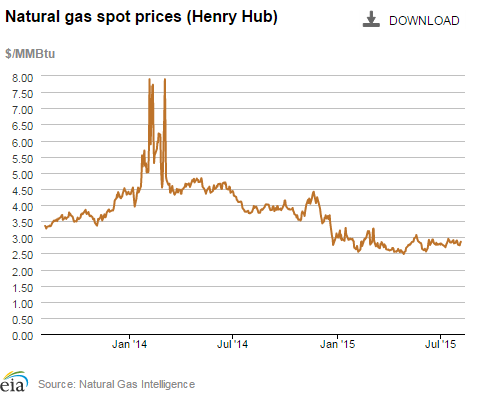
| Spot Prices ($/MMBtu) | Thu, 30-Jul |
Fri, 31-Jul |
Mon, 03-Aug |
Tue, 04-Aug |
Wed, 05-Aug |
|---|---|---|---|---|---|
| Henry Hub |
2.85 |
2.77 |
2.75 |
2.82 |
2.86 |
| New York |
2.85 |
2.17 |
2.52 |
1.98 |
1.75 |
| Chicago |
2.89 |
2.82 |
2.81 |
2.88 |
2.94 |
| Cal. Comp. Avg,* |
2.99 |
2.91 |
2.93 |
2.98 |
3.01 |
| Futures ($/MMBtu) | |||||
| September contract |
2.768 |
2.716 |
2.748 |
2.812 |
2.798 |
| October contract |
2.797 |
2.749 |
2.777 |
2.841 |
2.821 |
| *Avg. of NGI's reported prices for: Malin, PG&E citygate, and Southern California Border Avg. | |||||
| Source: NGI's Daily Gas Price Index | |||||
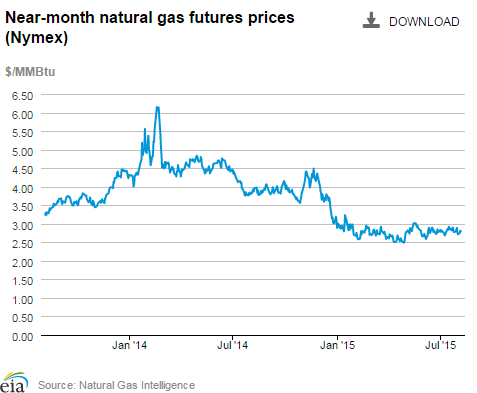
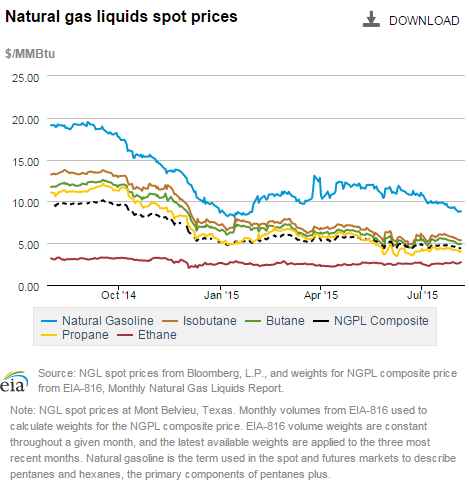
| U.S. natural gas supply - Gas Week: (7/29/15 - 8/5/15) | ||
|---|---|---|
Percent change for week compared with: |
||
last year |
last week |
|
| Gross production | 4.68%
|
0.16%
|
| Dry production | 4.64%
|
0.16%
|
| Canadian imports | 13.06%
|
2.97%
|
| West (net) | 16.34%
|
10.55%
|
| Midwest (net) | -0.85%
|
-6.19%
|
| Northeast (net) | -109.50%
|
-207.86%
|
| LNG imports | 241.37%
|
12.01%
|
| Total supply | 5.52%
|
0.40%
|
| Source: BENTEK Energy LLC | ||
| U.S. consumption - Gas Week: (7/29/15 - 8/5/15) | ||
|---|---|---|
Percent change for week compared with: |
||
last year |
last week |
|
| U.S. consumption | 10.5%
|
-0.5%
|
| Power | 25.9%
|
-0.6%
|
| Industrial | -2.7%
|
-0.1%
|
| Residential/commercial | -3.8%
|
-0.8%
|
| Total demand | 11.2%
|
-0.7%
|
| Source: BENTEK Energy LLC | ||
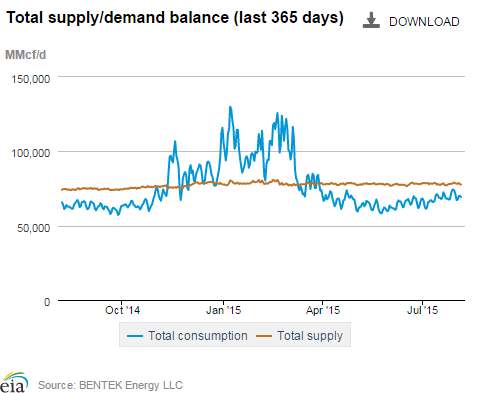
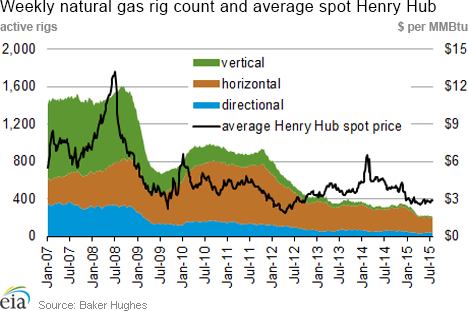
| Rigs | |||
|---|---|---|---|
Fri, July 31, 2015 |
Change from |
||
last week |
last year |
||
| Oil rigs | 664 |
0.76% |
-57.79% |
| Natural gas rigs | 209 |
-3.24% |
-33.23% |
| Miscellaneous | 1 |
0.00% |
-66.67% |
| Rig numbers by type | |||
|---|---|---|---|
Fri, July 31, 2015 |
Change from |
||
last week |
last year |
||
| Vertical | 126 |
-3.82% |
-66.22% |
| Horizontal | 664 |
0.30% |
-48.84% |
| Directional | 84 |
1.20% |
-61.47% |
| Source: Baker Hughes Inc. | |||
| Working gas in underground storage | ||||
|---|---|---|---|---|
Stocks billion cubic feet (bcf) |
||||
| Region | 2015-07-31 |
2015-07-24 |
change |
|
| East | 1,354 |
1,318 |
36 |
|
| West | 466 |
464 |
2 |
|
| Producing | 1,092 |
1,098 |
-6 |
|
| Total | 2,912 |
2,880 |
32 |
|
| Source: U.S. Energy Information Administration | ||||
| Working gas in underground storage | |||||
|---|---|---|---|---|---|
Historical comparisons |
|||||
Year ago (7/31/14) |
5-year average (2010-2014) |
||||
| Region | Stocks (Bcf) |
% change |
Stocks (Bcf) |
% change |
|
| East | 1,210 |
11.9 |
1,423 |
-4.8 |
|
| West | 386 |
20.7 |
447 |
4.3 |
|
| Producing | 781 |
39.8 |
978 |
11.7 |
|
| Total | 2,377 |
22.5 |
2,848 |
2.2 |
|
| Source: U.S. Energy Information Administration | |||||
| Temperature -- heating & cooling degree days (week ending Jul 30) | ||||||||
|---|---|---|---|---|---|---|---|---|
HDD deviation from: |
CDD deviation from: |
|||||||
| Region | HDD Current |
normal |
last year |
CDD Current |
normal |
last year |
||
| New England | 1
|
-1
|
0
|
50
|
5
|
17
|
||
| Middle Atlantic | 0
|
-2
|
-3
|
75
|
16
|
34
|
||
| E N Central | 0
|
-4
|
-14
|
75
|
17
|
48
|
||
| W N Central | 0
|
-3
|
-4
|
85
|
13
|
34
|
||
| South Atlantic | 0
|
0
|
0
|
107
|
10
|
15
|
||
| E S Central | 0
|
0
|
-2
|
114
|
19
|
43
|
||
| W S Central | 0
|
0
|
0
|
145
|
19
|
22
|
||
| Mountain | 2
|
-1
|
2
|
76
|
-3
|
-18
|
||
| Pacific | 1
|
-1
|
0
|
57
|
10
|
-21
|
||
| United States | 0
|
-2
|
-4
|
88
|
13
|
19
|
||
|
Note: HDD = heating degree-day; CDD = cooling degree-day Source: National Oceanic and Atmospheric Administration | ||||||||
Average temperature (°F)
7-Day Mean ending Jul 30, 2015
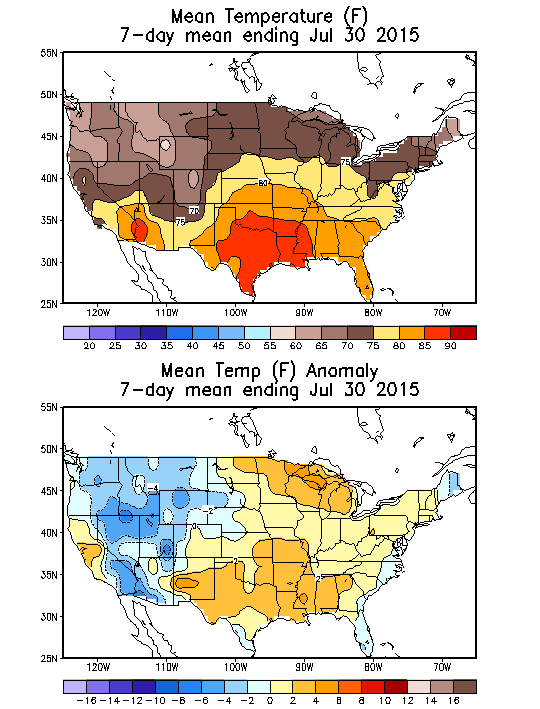
Source: NOAA/National Weather Service
Deviation between average and normal (°F)
7-Day Mean ending Jul 30, 2015

Source: NOAA/National Weather Service

